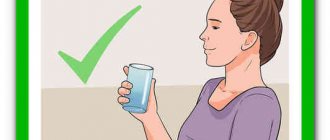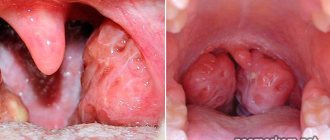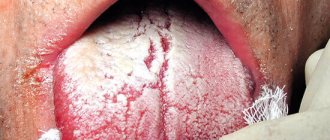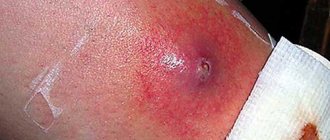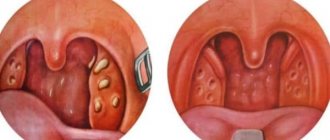This unpleasant phenomenon occurs not only during cold season. Purulent lesions of the palatine tonsils are especially common among children and young people under 35 years of age and signal serious problems in the body.
Even in the absence of high fever and other painful symptoms, plaque and pus on the tonsils should not be ignored, nor should you self-medicate. Both can lead to dangerous complications.
Reasons for the formation of ulcers
To understand why ulcers appear on the tonsils (or tonsils), you need to imagine the structure of these paired palatal formations. They consist of lymphoid tissue dotted with lacunae or crypts. This is the name given to canals with holes on the surface that open into the oral cavity. The diameter of the holes ranges from 1 to 4 mm. They become the site of accumulation of purulent masses and the formation of white ulcers on the tonsils.
Photo: structure of the tonsils
The purpose of the tonsils is to create a barrier to infection that seeks to enter the larynx, trachea, bronchi and lungs. When the onslaught of bacteria becomes too strong, symptoms of inflammation appear in the pharynx: an ulcer on the tonsil or several small ulcers, an increase in the volume of the tonsils (hypertrophy), the formation of a white coating on them, purulent accumulations in the lacunae. These accumulations scar over time and turn into plugs .
All these are symptoms of diagnoses such as chronic tonsillitis, tonsillitis, mononucleosis, diphtheria or candidiasis (stomatitis). Various microorganisms cause infections:
- adenovirus;
- streptococcus;
- staphylococcus;
- Pneumococcus;
- gonococcus;
- chlamydia;
- diphtheria bacillus;
- fungi of the genus Candida.
To get rid of suppuration, it is important to understand which pathogen caused it - the treatment regimen will depend on this.
The only way to determine this is to analyze a swab from a sore throat. That is why it is important, without wasting time on self-medication, to quickly consult a doctor. Especially if a plaque, ulcer or abscess is noticed on the child’s tonsil. And even if the body temperature remains within normal limits and there is no acute sore throat.
When to see a doctor: how does an ENT remove pus from the tonsils?
You need to contact an ENT doctor:
- With extensive raid.
- Pus on the tonsil on one side.
- In case of a pronounced systemic reaction of the body (fever, chills, sweating).
- Ulcers appear regularly.
The doctor decides how to remove the plugs and how to clean the tonsils during the examination.
To remove pus from the tonsils, the ENT doctor uses:
Sanitation of the tonsils - washing the lacunae with a syringe or sucking out the pus using a vacuum method. Using a special syringe, the doctor rinses the lacunae with antiseptic substances under pressure. This is the most common and accessible method.
The vacuum method is more effective. Using a special device, pus is sucked out of the tonsils. The cleaned lacunae are filled with medicine.
Physiotherapy helps cleanse the tissues in the throat, reduces swelling and inflammation. There are several types of physiotherapy used to treat the ENT organs.
Ultraviolet irradiation
- has a bactericidal effect, helps remove pus from the tonsils during tonsillitis.
Laser exposure
has an antimicrobial effect, improves blood and lymph circulation in inflamed tissues.
Ultrasound is a method
with the help of which drugs with a therapeutic effect (antibiotics, hydrocortisone, dioxidine) are introduced deep into the soft tissues.
Diagnostics
Diagnosis of diseases begins with detailing complaints and collecting anamnesis. An ENT doctor can make a preliminary diagnosis by examining the pharynx, assessing the condition of the throat and the nature of the plaque.
Identification of the pathogen that caused the disease is mandatory. For this, a throat swab is prescribed.
If necessary, additional studies are prescribed.
General blood analysis
allows you to determine the body's response to the inflammatory process.
Blood chemistry
with the detection of C-reactive protein, antistreptolysin-O, rheumatoid factor is prescribed if a streptococcal etiology of the disease is suspected.
Electrocardiography
may be needed to assess heart function in complicated diseases.
Purulent tonsils: symptoms and treatment
In most cases, pustular lesions of the throat cause associated symptoms such as:
- pain when swallowing or persistent pain;
- purulent taste and bad breath;
- temperature increase;
- general malaise, weakness;
- swollen lymph nodes;
- nausea, vomiting, loose stools;
- headache and ear pain.
In this case, you should immediately call a doctor. Before his arrival or before visiting the clinic, all that can be done to alleviate the condition is drinking plenty of fluids, bed rest and gargling every hour with a glass of warm, weak solution consisting of soda (1/2 teaspoon), salt (1 teaspoon) and iodine ( 2 drops). A solution of Furacilin (a tablet in a glass of water) or a decoction of a plant with an anti-inflammatory effect is also suitable:
- calendula;
- chamomile;
- yarrow;
- oak bark;
- sage;
- eucalyptus;
- series;
- sagebrush.
Antipyretic drugs are recommended to be taken only at temperatures above 38 °C. You should not remove purulent plugs on the tonsils on your own; the inflammation may intensify. Moreover, you cannot self-prescribe the first antibiotics you come across. They may not only not help, but also cause harm, complicating further treatment.
Nutrition should be gentle, mostly liquid. It is necessary to remove spicy, sour and sweet foods from the diet during treatment.
It is forbidden to make compresses or warm up the inflamed tonsils in any other way - this will increase the proliferation of bacteria and the formation of pus.
Sore throat alone, which causes ulcers and ulcers on the tonsils as in the photo, comes in different types: lacunar, follicular, phlegmonous. In all these cases, treatment is carried out in a hospital setting with antibiotics of the penicillin group, and if they are powerless - with macrolides, fluoroquinols, cephalosporins.
Photo: types of purulent sore throat
Feverish symptoms are not always observed. In a number of diseases, ulcers appear on the tonsils without fever, and the throat does not hurt. But this does not mean that the situation can be left to chance.
Pustules on tonsils with fever
The temperature reaction that accompanies infectious diseases indicates good immunity.
Sore throat is the most common pathology, in which a white coating appears in the throat and the temperature rises.
The ulcers are extensive, merge with each other, and extend beyond the tonsils. The patient experiences severe pain in the throat, burning sensation, and a feeling of a foreign body.
A specific symptom is the appearance of bad breath. The temperature rises sharply to high values, chills and body aches appear.
The second cause of ulcers in the tonsils is associated with chronic tonsillitis. It develops after frequent, untreated sore throats.
The inflammatory process is characterized by a sluggish course. The temperature rises slightly or not at all. The tonsils are almost always in the ulcers.
In more rare cases, a purulent throat with fever accompanies scarlet fever, diphtheria, leukoplakia, and syphilitic lesions of the mucous membranes of the oral cavity.
These diseases do not go away on their own and require treatment. Only a specialist can cure a patient without developing complications.
to the content?
Purulent tonsils without fever: diagnoses, treatment
Sore throat is not always accompanied by fever and severe malaise. For this reason, many do not complete the treatment of this terrible disease. This is where the development of chronic tonsillitis begins. This is the most common disease in which an abscess on the tonsil appears without fever and does not hurt, but poses a serious threat to the body.
Photo: chronic tonsillitis
With chronic tonsillitis, the tonsils become inflamed at the slightest hypothermia, exposure to infection, or are constantly in an inflamed state. Toxins, which are waste products of pathogens, enter the bloodstream and systematically poison the entire body, causing allergic reactions. This leads to a decrease in immunity, against the background of which a person becomes vulnerable to any infections. It turns out to be a vicious circle.
If there are ulcers on the tonsils and there is no temperature, treatment without medical supervision is also unacceptable. Chronic diseases are not treated with antibiotics so as not to further disturb the bacterial balance. Instead, local antiseptic drugs are prescribed: Grammidin, Miramistin, Lugol, Dioxidin, Octinecept. As well as therapeutic rinses and medicinal inhalations with a nebulizer.
Washing the tonsils with the “tonsillor” apparatus
At the same time, local immunity is activated with Immudon tablets or natural remedies: ginseng, propolis, pantocrine.
In addition to such conservative treatment methods, specialists in clinics also use modern ones:
- washing of festering lacunae with the “tonsillor” apparatus;
- laser therapy;
- ultrasonic irrigation;
- ultraviolet irradiation;
- vibroacoustic impact.
If, despite all efforts at systemic treatment, chronic tonsillitis worsens more than four times a year, the affected tonsils apparently cannot be cured and will have to be removed: instead of a barrier to the infection, they themselves have become its chronic focus.
In addition to tonsillitis, pus without fever can also cause other diseases . That is why before starting treatment, the doctor must establish the correct diagnosis. Sometimes people think, when they see white pustules on the tonsils, that it is a sore throat and swallow antibiotics, but the analysis shows that it is candidiasis, which can only be gotten rid of with antifungal drugs.
How to remove pus from tonsils yourself: can you squeeze it out?
It is not recommended to remove any deposits or formations on the tonsils yourself.
This can lead to injury to the mucous membrane if handled carelessly.
In addition, the products used may have a burning effect. As a result, such amateur activities can aggravate the underlying disease.
Currently, a popular method is when the patient, standing in front of a mirror, uses a cotton swab to press on the tonsil. When pressed, pus flows out or a hard plug comes out.
However, if excessive force is applied, surrounding tissues can become infected. Also, ulcers can be squeezed deep into the tissues and lead to the formation of an abscess.
Therefore, removing pus from the tonsils using this method should be done with caution, and it is better to entrust it to a specialist.
Removing pus from tonsils: video
Complications of purulent lesions of the tonsils
Self-medication of sore throat, chronic tonsillitis and other diseases that result in the formation of purulent plugs in the tonsils can undermine a person’s health for the rest of his life. As well as a negligent attitude towards this problem, especially if it does not bother you much during a chronic course.
The fact that an abscess on the tonsil is not accompanied by fever and does not hurt does not mean that its presence can be tolerated. This can lead to life-threatening local phenomena such as abscess, abscess and sepsis. And also cause systemic complications caused by the constant entry of toxins and particles of pus into the lymphatic and bloodstream:
- lymphadenitis;
- sinusitis;
- sinusitis;
- pyelonephritis;
- rheumatism;
- endocarditis;
- polyarthritis;
- adnexitis;
- prostatitis;
- cholecystitis.
An untreated sore throat can result in the same consequences when, after the acute symptoms have been relieved and the general condition has improved, the patient independently stops the medication course and observation by a doctor. Meanwhile, the inflammatory process quietly progresses and moves into a new stage of exacerbation or into a chronic form.
As long as there is at least one ulcer or abscess on the tonsil, treatment should not be stopped. Moreover, some purulent plugs and ulcers can only be noticeable during a medical examination.
A child has a white dot on his tonsil. What is this?
Children are more susceptible to any kind of infection. Having discovered a white spot on a child’s tonsil, a spot, first of all, you need to think about a sore throat.
Although this is a common disease, in the absence of adequate treatment it can lead to serious complications for the kidneys, heart, and lungs.
Therefore, if at least one abscess is found on the tonsil, it must be shown to a pediatrician.
Painless formations. When your throat doesn't hurt
There are situations when whitish dots on the back of the throat are an accidental finding. And the absence of tonsillitis is beyond doubt even for a “non-specialist”.
These formations are usually painless and have nothing to do with pus. In this case, you need to remember and assume what could have caused their formation.
Usually this:
- Small scratches that appear when the throat is injured by rough food or hard objects (the habit of putting a pen in the mouth). As they heal, such injuries become covered with a white coating.
- Oral thrush. It occurs, as a rule, without pain and fever. It develops against the background of reduced immunity after long-term use of antibiotics, cytostatics, and hormones. Specific fungal deposits form on the gums, soft palate, back wall of the pharynx and tonsils.
- Cystic formations of the posterior pharyngeal wall. Visually, the cyst looks like a white ball. Over time it increases in size.
- Pieces of food and dairy products can accumulate in the crypts and resemble pustular formations.
to the content?
How to get rid of ulcers on the tonsils for pregnant women and children
These are special categories of patients for whom many medications are contraindicated, while the immune system is not working at full strength. For pregnant women, sore throat is dangerous at any stage. In the first trimester, the disease can cause severe toxicosis, the threat of miscarriage, or disrupt the development of the unborn child.
At any time, typical complications of the disease may occur, as well as a weakening of labor due to a general decrease in the body’s defenses. Ideally, chronic tonsillitis is treated at the stage of pregnancy planning.
In a situation where abscesses on the tonsils appear in a pregnant woman, the therapist and obstetrician-gynecologist decide how to treat the disease. First of all, topical medications, antiseptic and anti-inflammatory rinses will be prescribed.
If in a serious situation the doctor prescribes antibiotic treatment, you should not refuse: they will bring more benefit than harm.
Pustules in the throat in infants under one year of age are usually treated in a hospital setting: the risk of rapid development of edema and severe intoxication is too great. In children older than one year, it is somewhat easier to treat ulcers that appear on the tonsils: they have already developed their own immunity. But he is still too weak to get rid of the pus without antibiotic therapy.
Children under 3 years of age are very prone to allergies, therefore, without consulting a pediatrician, not only antibiotics, but also herbal remedies should not be used to treat them.
To reduce the temperature from 38 °C, both pregnant women and babies are prohibited from taking aspirin . Only paracetamol-based drugs are allowed. You cannot steam your feet, do steam inhalations, or perform any other warming procedures.
How to remove purulent formations on the tonsils
Treatment of pus on the tonsils involves the use of drugs that eliminate pathogenic bacteria from the affected area, and general restoratives. Additional drugs are methods from traditional medicine. If drug treatment is not effective, surgery (tonsillectomy) to remove the tonsils may be required.
If going to the hospital is not possible, you can try to remove the pus yourself, but squeezing the pus out of your tonsils is not recommended. If squeezed out incorrectly, pus can get deep into the body, causing many complications. When squeezed out, abscesses can burst, spreading pus throughout the surrounding tissues or go deeper into the lymphoid tissue. It is also forbidden to use hot compresses on your own, because of bacteria, which, when the temperature of the affected area increases, begin to multiply en masse, which leads to complications.
Conservative treatment
To get rid of pus on the tonsils, the patient is prescribed medications that suppress the activity of bacteria. Medicines are prescribed by an otolaryngologist after bacterial culture. If treatment is not carried out properly, the disease leads to fever, damage to the cardiovascular system, purulent abscesses on the tissues surrounding the throat, inflammation through the auditory tube to the middle ear, with a noticeable decrease in hearing and sepsis, inflammation of the lymph nodes.
The following drugs are used to treat pus on the tonsils:
- Antibiotics of the antibacterial group, often penicillins, in the absence of individual intolerance. Strong antibiotics are not used for treatment, so the use of these medications is acceptable for children, the elderly and pregnant women.
- If the patient has a fever, antipyretics are used to improve the body's condition.
- Mouth rinsing with antiseptic drugs is prescribed to eliminate inflammation.
- For resorption, tablets with a bacteriostatic effect can be prescribed.
- If swelling is severe, antihistamines may be prescribed.
- General strengthening drugs, immunomodulators and vitamin-mineral complexes are required.
When undergoing medical procedures in a hospital, the patient may be treated with sanitation - washing the tonsils - to cleanse the lacunae of pus. To carry out the procedure, a syringe with a soft nozzle or a vacuum pump is used. Using a syringe nozzle, the treatment specialist cleans the lacunae under high pressure. When using a vacuum pump, pus is sucked out from the depths of the crypts, filling the remaining space with anti-inflammatory drugs.
Physiotherapeutic procedures are also used for treatment - UV irradiation of the mouth and throat, which helps relieve swelling of the tonsils and kills bacteria; laser exposure also eliminates bacteria and helps restore blood circulation in the affected areas.
In laser cryptolysis, radio waves are used to treat pus discharge from the tonsils. In this case, the crypts are cleaned and immediately closed, which prevents complications. The advantage of the method is that relapses are extremely rare.
Treatment with folk remedies
Treatment of tonsils at home is carried out in conjunction with a visit to the hospital for drug and physiotherapeutic treatment. Herbal teas are recommended to remove pus. Teas can be brewed from the following herbs: raspberry leaves, calendula, oak bark.
The following procedures can also be used for treatment at home:
- Mix 10 g of sea salt and a few drops of iodine for half a liter of heated water. A serving is enough for two times, rinse warm up to 7 times a day.
- Squeeze lemon juice into water in a 3:1 ratio. Gargle every 3 hours.
- Mix apple cider vinegar and beet juice in a ratio of 1:10. Rinse every 4 hours.
- Carrying out inhalations with essential oils of eucalyptus or fir.
During purulent tonsillitis, the attending physician may prescribe independent removal of pus from the tonsils. To squeeze pus out of the throat, you will need a blunt object, previously soaked in alcohol or an antiseptic, and a mirror. To clean the pus on the tonsils, you need to position yourself in front of a mirror so that you can see the abscesses and carefully press next to the abscess with any flat object. After the procedure, be sure to gargle to get rid of any remaining pus.
Prevention of purulent tonsillitis and chronic tonsillitis
If even a small amount of pus is noticed on the tonsils, treatment should be completed and secured with a restorative course. Only this will protect against tonsillitis becoming chronic.
After antibiotic therapy, it is necessary to take drugs with bifidobacteria and lactobacilli. To restore the local bacterial balance, it is useful to gargle with fermented milk products such as Narine.
Only an organism with high immune defense can independently fight streptococci, staphylococci and another three dozen types of pathogens that cause pustules on the tonsils. To do this you need:
Adequate nutrition with a sufficient amount of protein products in the diet: meat, offal, fish, milk, dairy products, as well as herbs, fruits and vegetables.- Replacing tea and coffee with herbal and fruit and berry restorative infusions.
- Hardening, which will help you endure hypothermia. And these are not only procedures that harden the entire body, but also local ones: for the throat. The procedure consists of gradually (by 0.5 degrees daily) reducing the temperature of drinks and rinses.
- Timely treatment of caries and other diseases of teeth and gums.
- A healthy and active lifestyle with no smoking and alcohol abuse, exercise and a positive attitude.
These simple rules will ensure health for many years and will help you endure infectious diseases without dangerous consequences.
Treatment
Treatment involves removing purulent plugs . If such formations do not cause fever and do not cause discomfort, then such a procedure will not be required. It is enough to periodically gargle with a special solution.
If the patient has large plugs in the tonsils, they are removed through surgery. In addition, to combat ulcers, the doctor treats the surface of the tonsils with antimicrobial solutions.
It must be remembered that sore throat can lead to the formation of congestion, so it must be treated carefully. If a person constantly regularly suffers from tonsillitis and at the same time has plugs on his tonsils, then removal of the tonsils is indicated. In less advanced cases, white plaque must be removed regularly. This is done once a day and then rinsed with a solution based on salt, iodine and baking soda.
As a rule, the doctor conducts a comprehensive examination and then removes the purulent plug with a regular syringe or special instruments. After this, an antibiotic is administered. In some cases, lacunae lavage is additionally prescribed. In addition, it is important to use vitamin complexes.
Folk remedies
To eliminate pus, you can use natural herbal teas. A solution of soda, salt and iodine is considered no less effective. to prepare decoctions :
- thyme;
- wormwood;
- sage
- raspberry and plantain leaves;
- Oak bark;
- calendula flowers.
For chronic tonsillitis, it is recommended to use cloves, which can cleanse the lymphatic system, as well as turmeric, which cleanses the blood and normalizes the intestinal microflora.
To get rid of congestion on the tonsils, you need to regularly drink hot herbal tea . Many experts recommend quitting smoking. It is also important to review your diet. So, to improve the condition and avoid the formation of traffic jams, you need to eat warm soups, vegetable salads and fresh fruits.


